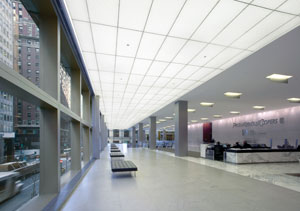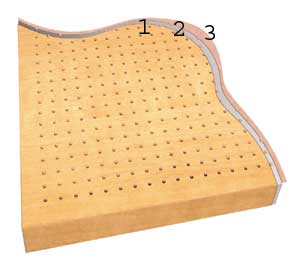Perforated Metal and Wood Ceilings: Sustainability, Acoustics, and Aesthetics
Automated equipment can perforate panels at 7,000 holes per minute.
|
Perforations are also the key to boosting the acoustical performance of panels. In a post-occupancy evaluation of over 180 workplaces, the Center for the Built Environment found that building occupants reported more dissatisfaction with acoustics in their workplaces than any of the other parameters measured. Architectural acoustical demands are higher today due, in part, to the challenges of improving employee satisfaction in open office environments, maintaining patient privacy in healthcare settings, and addressing new noise sources such as cell phones and desktop multimedia.
Researchers found building occupants report more dissatisfaction with acoustics than any other parameter measured.
Perforated ceiling systems deliver outstanding acoustics. Perforated panels typically achieve noise reduction coefficients (NRC) of NRC .75, and even as high as NRC .95 with additional insulation. More importantly, perforated panels can be tuned to satisfy the acoustical requirements of different rooms, such a providing speech privacy in an open office, clarity in a meeting room, and richness in a concert hall. Tuning an installation is accomplished by changing the perforation pattern, the type and placement of any acoustical insulation, and the distance from the panels to the structure above the ceiling. Noise reduction characteristics can vary significantly among similar ceiling products. When specifying ceiling products, architects should review test reports and available information to assess performance qualities. On complex projects, an acoustical consultant can be an invaluable member of the design team.
Perforated Metal and Wood
Most perforated ceilings are made of sheet metal. While perforated steel panels are available, the trend is towards the use of aluminum panels that are lighter in weight and can have higher recycled-material content. Metal ceilings are available prepainted in a wide spectrum of colors, with mirrored or anodized surfaces, and with other unique finishes to fit almost every style or taste.
|
Recent advances in perforating wood ceilings expand design options still further. Until recently, wood panels were made with wood veneers laminated to wood or particleboard cores. The resulting panels were heavy, especially where large panels were required, and difficult to fabricate into curved surfaces. The acoustical performance of wood panels was limited by the cost to drill holes in the panels. Even with "gang-drilling," making holes in wood panels was slow. The heat from high speed drilling could char a wood core. This meant that perforated wood panels were practical with only limited design options and a relatively small percentage of the open area necessary for a full range of noise control options. Drilled panels, for example, are typically limited to NRC .45, far below the NRC .75 to .95 required in rooms with critical noise control requirements.











